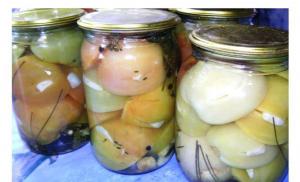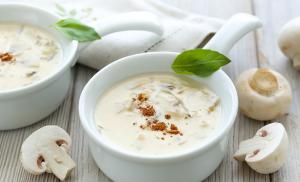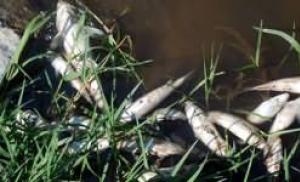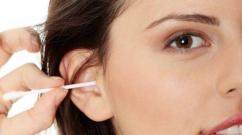What do copperheads eat? Common copperhead - the snake of our forests
The common copperhead is a relatively small (up to 70 cm long), massive and strong snake. The tail makes up a fourth or fifth of the total length. She has a flattened head and weakly demarcated from the neck. The scales are smooth.
The upperparts are grayish or brown, sometimes with a red tint. Reddish coloring is more common in males, brown - in females. Against this background, there are two to four longitudinal rows of dark spots on the back, sometimes unnoticeable. There is often an arched dark stripe on the head. A dark stripe runs from the nostril through the eye to the corner of the mouth, and the eyes themselves are often red. Small specks are scattered on the sides of the body. The underside of the body, like the upper, is gray, brown, pink or reddish in color. The pattern of the ventral side consists of dark blurry spots and specks, sometimes a dark gray stripe runs down the middle of the abdomen. The underside of the tail is lighter colored. Newborn copperheads are brighter in color: the dark pattern on their back is distinct, and the underside of the body is red. Thanks to the reddish tint of the back and copper-red belly, this snake got its name.
Due to its massive build and similarity in color, the copperhead is often confused with common viper. The most noticeable differences between these cohabiting species are as follows. The viper has a spear-shaped head and is clearly demarcated from the neck. in the copperhead it is narrower and the neck interception is faintly noticeable. The head of the copperhead is covered with large scutes, while that of the viper is covered with small ones. The body scales of the viper are ribbed, while those of the copperhead are smooth. The pupil of the copperhead is round, while that of the viper is vertical.
Range of the common copperhead
The range of the copperhead includes almost all of Europe, Western Kazakhstan, Asia Minor, the Caucasus, and Northern Iran. In Russia the species inhabits European part, reaching in the north to Lake Onega, in the east - to Western Siberia.
The common copperhead is an inhabitant of wooded areas. It is found in deciduous, coniferous and mixed forests, sticks to sun-warmed edges, clearings, and overgrown clearings. In open areas - steppe areas and meadows - it is observed less frequently. In the mountains, it is common on bush-covered slopes, sometimes found in meadow and subalpine zones, rising to a height of 3000 meters. The population density of the copperhead is quite low everywhere; this snake is much less common than the vipers and grass snakes that live together with it. In many parts of its range, especially in the north, it is known only from isolated finds.
Copperhead lifestyle
The copperhead leads a mainly terrestrial lifestyle, although it can also crawl onto the branches of bushes. Shelters include rodent burrows, spaces under stones and tree trunks, and cracks in rocks. The copperhead avoids damp places and enters water very reluctantly, although if necessary it can swim quite well. She is thermophilic and usually active in warm weather. daytime. However, sometimes it crawls to the surface at dusk or on a clear moonlit night.
Copperheads are very attached to specific place residence: each individual lives in a relatively small individual area, where it can be found from year to year.
Copperheads have a characteristic defensive behavior. When attacked by an enemy, she curls up into a tight ball, inside which she hides her head. She reacts to attempts to touch her by shrinking even more. From this position he can make throws towards the enemy with a sharp hiss. When picked up, the copperhead bites fiercely and can bite through the skin until it bleeds. Perhaps this explains the hostility of people towards the copperhead in many places where it is distributed. Sometimes it is completely unreasonably considered the most poisonous snake, more dangerous than the viper. In addition, like snakes, copperheads can “shoot” at the offender with secretions of the cloacal glands.
Defensive behavior and resemblance to a viper do not always save the copperhead. It is obtained by various birds, martens, wild boars, hedgehogs and even rats. Newborn copperheads can also be eaten by such non-dangerous animals as grass frogs or large songbirds.
In captivity, these snakes are less likely to show their unfriendly nature and gradually become so accustomed to the terrarium that they take food from the owner’s hands.
What do common copperheads eat?
The common copperhead eats a wide variety of vertebrates that it can find in its distribution areas, but prefers lizards of all kinds. It is rather slow and hunts not active animals, but those resting in shelters. That is why it often preys on secretly living spindles. It often lies in wait for its prey, sitting motionless in ambush, and then quickly rushes at the unsuspecting lizard when it crawls close enough. It wraps the victim in rings around its body, but sometimes does not strangle it, but thus holds it in a position convenient for swallowing. The copperhead's muscles are more developed than those of the grass snake or viper; it is capable of holding with its rings even such a small “detail” as a lizard’s foot. It can be difficult for a small snake to cope with large, strong lizards. Sometimes real battles take place, in which the snake often wins. True, it happens that a defeated lizard, in its death throes, clings its jaws so tightly to the snake that, swallowing its prey, the copperhead tears it away from itself, like a bulldog, sometimes along with its own skin. Her poisonous saliva, which is dangerous for cold-blooded animals, also helps her cope with lizards, which enters the victim’s blood with a strong bite.
Obviously, the poison helps to deal with other victims - on occasion, they become snakes and other snakes. There are known cases of cannibalism. Copperheads have an excellent appetite. It can swallow very large prey (for example, in the stomach of a snake 57 centimeters long a spindle 35 centimeters long was found), and several animals at once (three viviparous or agile lizards). While exploring various secluded places in search of prey, the copperhead also crawls into rodent burrows and willingly eats naked cubs there.
In spring copperheads are found in pairs. Like slender snakes, during mating the male holds the female by the neck with his jaws, wrapping himself around her body. Mating can also occur in the fall - in this case, the female brings offspring the following summer.
Reproduction of copperheads
Female copperheads give birth to live young in egg shells. Snakes 12-17 centimeters long that are born immediately break these shells and begin independent life. One female brings from 2 to 15 cubs. Newborns can eat insects, but, like adults, they prefer lizards, albeit small ones. Sexual maturity is reached in the third year of life.
The low abundance of copperheads everywhere is obviously explained by their gastronomic predilection for feeding on lizards. This food supply is not as extensive and reliable as frogs or small rodents. The widespread decline in lizard numbers is leading to an even greater decline in copperhead populations. The constant extermination of these snakes by people also has an effect. As a result, the copperhead is endangered in many areas of its distribution. In a number of European countries it is protected by law.
Most people tend to be afraid of snakes because of their poisonous bites, and almost always meeting them causes a subconscious fear. There are many superstitions about snakes. And the common copperhead snake is also endowed by nature with red eyes, therefore before people considered her an unambiguous product dark forces, a devilish spawn capable of destroying the owners of the house and livestock to boot. Despite the fact that the copperhead is quite widespread, people do not know much about it. Some even think it is a legless lizard. In fact, the copperhead is a snake. Is it really that dangerous, and is the common copperhead snake poisonous?
Habitat and appearance
Representatives of these reptiles belong to the species non-venomous snakes, a genus of copperheads (family Colubridae). There are three species in the copperhead genus.
They live:
- in northwest Africa,
- south india
- on the territory of Europe.
The copperhead is distinguished from other snakes found in Europe by its round pupils with a dark stripe running across the entire eye. Sometimes the eyes of copperheads are red. The snake got its name because of its color.
copperheads living in Russian forests, belong to the ordinary species. Their teeth are poisonous, but their mouths are so small that they cannot bite a person, and even if they bite mortal danger for humans no.
Photo and description of the copperhead snake
What does a copperhead snake look like? The color of the copperhead depends on its habitat - it varies from light gray to almost black. The snake's belly is copper-red, its back can be from gray or yellow-brown to brown-copper-red. Copperheads with a predominantly gray color are found mainly in the southern regions. When a snake molts, its color becomes darker than usual - the gray color can change to dark brown and even black.
Males have a pronounced copper color; females are usually gray. The color of young snakes is always brighter; it fades with age, so identifying a young snake is very easy.
Usually the coloring of copperheads is monotonous. But there are also specimens with a patterned pattern - with longitudinal lines along the entire body. In this case top part The sides of the body are decorated with 2-4 rows of oval vertical spots - from light brown to black. Sometimes they are weakly expressed (almost unnoticeable), but clearly visible on the snake’s neck, sometimes they are bright throughout the body, merging into stripes, and on the back of the head there are two dark spots merging with each other. There may be a pattern on the back that consists of diamond-shaped or hexagonal spots, which makes the copperhead look like a miniature viper.
In nature, copperheads reach maximum length only 70 cm, but its small size is compensated by developed muscles. Distinctive feature This snake has a head that is almost completely fused with the body.

Habitats and habits
Basically, copperheads are found in deciduous forests, but sometimes they are also found in pine forests and spruce forests. The snake prefers deciduous forests because it is easier for it to get food there - abundant prey is hidden in fallen leaves. It is extremely rare to see a copperhead in a meadow or steppe - open space provides an opportunity for the snake’s natural enemies to make it their prey. However, copperhead nests are made near open places - near clearings, near small clearings.
Like many reptiles, copperheads love to bask in the sun's rays. They are active during the daytime and rarely go hunting at night. In the dark, cool time of the day, these snakes hide in their shelters.
The common copperhead snake is a solitary snake by nature. Sometimes it can even attack a relative - if the neighbor is undesirable to it. A furious attack (bites) awaits the enemy, sometimes leading to cannibalism. Therefore, it is almost impossible to meet two individuals in one small area. These snakes communicate exclusively during the mating season, and after mating they scatter in different directions and never meet again.
Copperheads are very attached to their nests and can live in one “house” throughout their lives. A snake that encroaches on its home will immediately attack, so it is not recommended to look into its hole or stick a stick into it.
Copperheads can swim excellently, but are reluctant to do so. The snake goes into the water only when absolutely necessary and never chooses wet places to live.

In a person’s hands, wild animals behave extremely aggressively and can bite until they bleed. It was precisely from this behavior of these reptiles that the question arose - is the copperhead snake poisonous or not for humans, and how dangerous can this creature be? In reality, the snake behaves this way out of fear, and when kept in captivity, after some time it gets used to its terrarium, becomes loyal to its owner, and can take food from human hands.
What do copperheads eat?
IN natural conditions The main food of these snakes are lizards from the Veretenitsev family - they are nimble, they have no legs, and their body is serpentine; the diet of the copperhead consists of almost 60% of them. About 5% of the diet consists of small vertebrates.
The copperhead can eat:
- mouse,
- frog,
- chick of a small bird (tit, sparrow, etc.).
- They eat copperheads and insects.
Occasionally, these snakes have cases of cannibalism.
Copperheads are quite slow - if potential prey notices a snake, it can easily hide. Therefore, the copperhead hunts, hiding in fallen leaves and tall grass, waiting for the prey to come closer. After the “food” is in close proximity, the snake rushes at it and, thanks to its developed muscles, easily holds it, wrapping it around its body. The grip is so powerful that the caught lizard or mouse cannot even move. As soon as the prey is caught, the reptile begins to slowly eat it.

Reproduction
Copperheads are active for about six months - from March to August. During this period, they leave offspring, and go to winter in September-October. The mating season for these snakes is spring. But mating also happens in autumn months– then the female’s sperm receptacles store the sperm until leaving the winter quarters, and the cubs themselves will still appear only in the summer.
During the mating process, the male holds the female by the neck with his jaws and wraps himself around her body. At the end of fertilization, the snakes leave each other. In the brood of one female there are up to 15 eggs.
Baby snakes are born in egg shells - already ready-made viable individuals, since the copperhead carries eggs within itself until the development of the embryo is completed. They immediately break through the shells and immediately begin an independent life. The body length of a newly born snake is as much as 12-17 cm. Babies mainly feed on insects, and less often on very small lizards.
Sexual maturity in copperheads occurs in the 3rd year of life.

Lifespan
Under natural conditions, the common copperhead snake can live from 12 to 15 years, but in fact average age these snakes in wildlife does not exceed 10 years, since the number of dangers and enemies is large. And at home with proper care the snake will live the maximum period allotted by nature.
Is the copperhead snake poisonous or not?
Despite their rather menacing appearance, aggressive disposition and eerie red eyes, they do not pose a threat to human life. Even if this snake bites the skin until it bleeds, its bite is not poisonous, and there will only be a burning sensation at the site of the bite. The only thing that will cause discomfort is the wound, which needs to heal, and the psychological moment – fear. These snakes have glands that produce poison, but the amount of poison is so small that it has no effect on humans at all. The venom of copperheads is deadly only for lizards, small birds and rodents and other similar living creatures.
The answer to the question - is the copperhead a snake or a lizard - is given by science. Scientists classify this animal from the class of reptiles to the suborder of snakes.
The common copperhead takes its place in the Red Book - in some European countries (including Belarus and Ukraine) it is protected; the law prohibits the catching and destruction of these snakes. But it is not included in the Red Book of Russia, but it is protected by regional Red Books: copperhead under state security 23 regions of the Russian Federation, Bashkortostan, Mordovia, Chuvashia, Udmurtia, Kalmykia and Tatarstan. In the Vladimir and Penza regions, the snake is included in the annexes to the local Red Data Books.
And read about another representative of the world of snakes - the yellow-bellied snake.
Did you like the article? Take it to your wall and support the project!
Many snakes inhabiting the planet are deadly to humans (see). Reptiles live almost everywhere, they are not found only in Antarctica. When going into the forest to pick berries and mushrooms, on a hike or on a picnic, you need to be prepared to meet the local inhabitants - snakes. Not all cold-blooded snakes pose a threat to human health, so every wildlife lover should be able to distinguish dangerous snakes from non-venomous ones. The copperhead is very common in nature and sometimes attacks people. Is a copperhead bite poisonous and what should you do if you encounter a snake?
Since ancient times, people have been wary of snakes. It was believed that if poisonous reptile bites a person, the victim could save his life only by cutting off the stung limb or cutting out the affected area with a knife. Since not all cold-blooded animals possessed potent toxins, the victim often died from blood poisoning due to pathogenic microflora entering the wound during the “operation.”
Who is this copperhead?
In the territory Russian Federation The copperhead is found in almost all regions of the country. The snake grows no more than 70 cm long and has a well-developed muscular body. The reptile has a brown or grayish tint, on which a reddish sheen is clearly visible in sunlight. It is for this body color that she got her name. Unlike the viper, which has a spear-shaped head, the upper part of the copperhead's body looks as if it has grown into the neck. Reptile pupils are always round shape, although in the same viper they are extended vertically (see).
The copperhead does not have poisonous front teeth. The snake prefers conifers and pine forests, loves to bask in sunny edges and clearings with tall grass. Very rarely, the reptile is found in fields, meadows, along rivers and lakes. Sometimes the snake prefers to bask on the branches of trees and bushes. The copperhead hunts mainly during the daytime, but sometimes crawls out at night. It chooses small rodents, birds, lizards and insects as food. There are cases when a reptile ate its own kind.
Find out what is dangerous: symptoms and consequences.
Did you know that a bite is considered dangerous? Symptoms of poisoning, first aid.
During the winter, snakes always hibernate, waking up only in spring, when Sun rays warmed the ground well. Copperheads prefer to lead a solitary lifestyle, meeting with a partner only during the mating season. After the snake lays its eggs, it guards them for some time. In one clutch, a female copperhead can lay up to 15 eggs. As a rule, the cubs, still in the egg, are already ready for life. After the birth of little snakes, their mother leaves her nest forever, giving her offspring complete independence. Tiny reptiles already have hunting skills from birth and do well without maternal care. The lifespan of this reptile ranges from 10 to 13 years.
For humans, a snake bite is completely safe. When meeting a person, the reptile sometimes attacks, but only in self-defense. A copperhead snake is also capable of biting due to penetration into its hole. However, snake bites are not considered safe for all people. May be affected:
- persons with allergic reactions;
- people with weak immunity;
- Small children;
- old men.
Important! In some cases, the victim is not even able to understand that he was bitten by a copperhead, which is why it is necessary to know the signs of a snake bite.
Symptoms
Is a copperhead bite dangerous for humans? A snake almost never attacks people first; if it bites a person, it is solely to protect its own life or the peace of its offspring. The reptile often attacks small children, as they like to stir up various holes with sticks. Photo and description of a bite from a copperhead snake:

Attention! If the victim is susceptible to allergic reactions, a copperhead bite is considered dangerous for him and can cause negative health consequences. If any severe symptoms occur, you should immediately seek medical help.
First aid for a bite
As soon as a person experiences symptoms from a copperhead bite, the victim must be given first aid. It is advisable to immediately rinse the wound with running water. clean water: This will reduce the amount of dirt that gets into the wound through the snake's teeth. Within half an hour, it is recommended to treat the affected area with any antiseptic; an alcohol solution of iodine or weak potassium permanganate is best. To relieve swelling, apply ice, a napkin moistened with cool water, or plastic bottle filled with cold liquid.
In case of severe pain, the victim is given painkillers. If a person is prone to allergies, he needs to take an antihistamine. The bitten person is provided with complete rest and plenty of warm drinks.
If health deteriorates or there is purulent inflammation of the wound, it is recommended that the victim be immediately taken to a medical facility.
Prevention of bites
Despite the fact that the copperhead is not a dangerous venomous snake, its attack can sometimes result in negative consequences for the victim. To avoid this, you need to follow simple rules:
- Every person visiting the wild should be able to distinguish poisonous snakes from completely harmless ones (see).
- When walking through forests, forest edges and other areas where snakes may live, your feet should be wearing rubber boots or shoes made of thick leather that the reptile cannot bite through.
- Children should be explained that teasing a snake is dangerous, and that they should not pick their holes with sticks.
- When meeting a cold-blooded person, it is better to avoid him.
- When picking berries and mushrooms, you should wear thick gloves on your hands.
- It is imperative to know what symptoms occur from a copperhead bite in order to accurately identify this snake from other reptiles.
Find out what to do if: first aid.
Read whether it counts: symptoms of a bite, first aid, treatment.
Find out what to do: symptoms and first aid.
Conclusion
The copperhead is one of the most common snakes in the forest. Since it has some similarities with a viper, a person can easily make a mistake and take it fatally. dangerous snake for being harmless. Despite the fact that the reptile is not poisonous, it is not worth provoking a cold-blooded reptile to attack. The copperhead's bite sometimes causes severe allergic reactions which are considered dangerous to human life.
These animals with an elongated body have no limbs. Snakes are the subject of many legends. Many, not knowing the differences, consider most of them to be poisonous and kill them. The most common snakes include copperheads and vipers.
These scaly reptiles are among the most ancient on our planet. Their elongated body, the length of which can range from ten centimeters to seven or more meters, has no limbs. Most snakes are less than a meter long. They are believed to have evolved from lizards. Today it is known more than 3630 species of snakes, a quarter of which is poisonous. They live on all continents except Antarctica. There are especially many of them in the tropical regions of the Earth. They are absent only on a few large and many small oceanic islands.

They have asymmetrically located internal organs elongated shape. Their heart can move as swallowed prey passes through the esophagus. Before reaching the heart, the blood of snakes from the tail passes through the kidneys. They use their forked tongue, which is in constant motion, to collect particles. environment. This information, as well as the eye's motion-tracking function, helps locate prey. Snakes have high thermal sensitivity, allowing them to perceive infrared radiation. In the absence of hearing, they subtly sense the vibration of the earth and the approach of people and other animals.
Is copperhead poisonous?
The snake, called the copperhead, comes from the snake family. She lives in everyone European countries, in the Caucasus, Kazakhstan and Iran. She is thermophilic, and the border of her habitat is where average temperature July does not fall below 18 degrees. Masters rocky places in steppe zones. Adapted to life in the mountains. Finds refuge under the bark fallen trees, in rock cracks, burrows of lizards and rodents . Her lifestyle is predominantly daytime. She is most active in the morning and evening.

It can crawl out to hunt at dusk and on bright moonlit nights. Its food is mainly lizards. It also hunts mice and chicks of small birds. It usually paralyzes its prey with toxic saliva, squeezing its body in rings, and then swallows it alive. She leads such a life for about six months. They may go into hibernation in September. It does not change its habitat for several years. Copperheads live up to 12 years. They can reach a length of 90 cm, although it rarely exceeds 70 cm. Its tail is several times smaller than its body.

The copperhead's back can range in color from gray to yellow-brown, as well as copper-brown-red. Often during molting it can turn brownish-black. If the color is dark, the belly of such a copperhead may be black. Young snakes often have a bright orange abdomen. The copperhead can be identified by its round pupil and the iris of its eyes, which can be red or yellow color, sometimes two-color. On its sides there are usually several rows of spots elongated across, sometimes merging into stripes. The scales on the back are hexagonal or diamond-shaped.

Sometimes, when meeting a copperhead, they kill it, mistaking it for a poisonous snake. However, its bite is safe for humans, except for punctures on the skin from the teeth with droplets of blood.
How scary is the viper?
Viper refers to poisonous snakes from the viper family. It is common in many regions of Europe and Asia. It can be found in the northern regions and at an altitude of two thousand meters. It lives mainly on the banks of rivers and lakes, on peat bogs, in light mixed forests, on the edges of fields, grassy areas. Burrows for wintering are chosen up to two meters deep, where the temperature is slightly above zero. Hundreds of these snakes can hibernate in such a place. The size of vipers is relatively small. Together with the tail, their length is usually within 65 centimeters. In some countries they can be twenty centimeters longer. An adult can weigh from fifty to 180 grams.

They live on average fifteen years. The viper has a large, slightly flat and rounded head with vertical pupils. In color it can be similar to a copperhead; in some places black vipers predominate. The tip of her tail is yellow, orange or red. The main difference is the dark zigzag stripe on the back. The viper has many enemies. It dies as a result of human intervention in nature and deforestation. Sometimes they are deliberately destroyed, caught for terrariums, to collect poison. Vipers are hunted by hedgehogs that are immune to their poison, as well as foxes, ferrets, badgers, eagles and owls.

The bite of this snake is dangerous for humans, but deaths are not common. There is no need to panic until you see a doctor immediately. Apply a pressure bandage to the bitten area. You should drink a lot. Usually, after a few days, the consequences of the bite go away. Sometimes the effects of the poison are felt for several months. To avoid this, it is not recommended to undergo treatment without consulting a doctor.
What is their difference
The copperhead, which is safe for humans, has several characteristics that significantly distinguish it from the poisonous viper.
- The copperhead has a slightly ovoid oval head. Viper head triangular shape. It is clearly demarcated from the neck. The superciliary ridges are visible above the eyes of the viper.
- On the head of the copperhead there are symmetrical shields that have the correct shape. On the head of vipers there are three triangular shields, the shape of which is irregular.
- The copperhead's pupil is only round. The vertical pupil of the viper is similar to that of a cat.
- The copperhead has a thin and a long tail. The viper has a thicker and shorter body with a blunt and short tail.
- Copperheads have rows of small spots and dots running along their back that stand out against the background color. Almost all vipers have a dark zigzag stripe on their backs, with the exception of black vipers, which have no pattern.
- The abdomen of copperheads changes color from light to variegated, turning into
- Umedyanka does not have a narrow elevation in the middle of each scale. Vipers have it.
- Copperheads do not have poisonous teeth. Vipers have poisonous teeth in front of their mouths that rotate 90 degrees.
- The shield covering the anus of the copperhead consists of two scales. Vipers have one, and do not separate.
- The copperhead is more thermophilic than the viper.
Man has always been very wary of snakes. Any contact with them inevitably provokes fear, mystical associations and superstitious speculation. And if the snake also has red eyes, like a copperhead, then it was considered 100% the product of black power, witchcraft, designed to destroy the owner of the house, his household and cattle in addition. In general, everything is not easy with the copperhead. Despite the fairly wide distribution of this snake, people know little about it. And, either he takes her for the devil's spawn, or - for legless lizard. The copperhead is neither one nor the other.
Description of the copperhead
The common copperhead is a species of non-venomous snake of the genus copperhead, a family of colubrids.. The copperhead is a small snake, but strong and strong. With a body length of no more than 70 cm, it manages to instill a lot of fear in humans and be very dangerous for small rodents and even its relatives.
Appearance
The color of the copperhead is clear from the name. Varying from light gray to almost black, most copperheads are copper-red on the belly and reddish on the back. It is believed that gray copperheads live mainly in the southern regions. It has also been noticed that during the molting period, the copperhead becomes darker than its usual color and can turn from gray to dark brown and even black.
This is interesting! The copperhead's eyes are often red and its tail is 4 times smaller than its body.
Male copperheads differ in color from females. Their tones are reddish, while those of females are brownish. You can also determine the age of the copperhead by the intensity of the tone. Young snakes are always brighter. If there is a pattern, then it is more contrasting and noticeable. As for the pattern on the general background, it is not a mandatory sign of the common copperhead. In some individuals, the body has brown and black spots and lines, in others it does not, or these spots are so faintly expressed that they are almost indistinguishable.
There are 5 characteristic features copperheads. They are - distinctive features it is from, with which the copperhead is often confused due to the similarity in size and color.
Flat head, almost merging with the body.
- The viper has a clear line between its head and body.
The head is covered with large scutes.
- The viper has small scutes.
The scales are smooth, with shiny copper tints.
- The viper has ribbed scales.
The pupil of the copperhead is round.
- The viper has a vertical pupil.
The copperhead does not have poison-conducting teeth.
- The viper has it.
Lifestyle, behavior
The copperhead is thermophilic. She chooses open clearings and clearings for nests, and on a good day she loves to soak up the sun. For the same reason, this snake is active during the day and rarely goes out hunting at night, preferring to stay in its shelter when it is dark and cool.
The copperhead is tied to its nests. And he is in no hurry to change his habitat - a favorite crack in a rock, between stones, an old rodent hole, the emptiness under the bark of a fallen tree. Having chosen a cozy place, this snake will be faithful to it all its life, unless someone destroys its home.
Medyanka - loner. She doesn't need company. Moreover, this snake will protect its territory from its relative. If necessary, he will even launch a violent attack on an unwanted neighbor, bite him and eat him. That is why you cannot find two copperheads in one small area. The only period when these snakes communicate is mating. But after intercourse, the partners’ paths diverge forever.
Copperheads swim well, but don't like to do it. They come into contact with water extremely reluctantly and out of necessity. They never settle in damp places.
Copperheads are slow. For this reason, they have special hunting tactics. They do not pursue game, but prefer to watch for it, remaining motionless in ambush long time. When the opportune moment comes, the snake lunges towards the victim and grabs it. Powerful muscles allow the copperhead, holding its prey with an iron grip, to wrap itself around it so tightly that it becomes completely motionless. These tight hugs are not necessary to strangle the victim. The copperhead may well hold it tightly to make it easier to swallow it whole.

The copperhead has a characteristic defensive tactic. In the case when the victim is the copperhead itself, it uses defensive tactics: it curls up into a tight ball, inside which it hides its head. From time to time, she sharply sticks her head out of the ball and makes a throw towards the enemy.
In the hands of a person, a wild copperhead will not behave quietly, but will attempt to bite. She can bite through skin until it bleeds. Perhaps this unfriendly behavior gave this snake a bad reputation - poisonous and dangerous. But in fact, she behaves this way because she is very scared. Proof of this is the behavior of the copperhead in captivity. Over time, this snake gets used to the terrarium and even begins to take food from the hands of its owner.
Lifespan
In the wild, the long-lived copperhead is 12-15 years old. But often she does not live to see 10 years old, due to the huge number of enemies and dangers that lie in wait for her. In captivity, with good care, these snakes have a good chance of living longer.
Is copperhead poisonous?
In Rus' there was a belief that the bite of a snake with copper-colored scales dooms a person to certain death. According to popular rumor, death must certainly occur by sunset and save the victim poisonous bite Allegedly, only extreme measures could be taken - a severed arm/leg or a cut piece at the site of the bite. Scientists are cooling down hot superstitious heads: copperhead is not dangerous for humans. And in general, it belongs to the family of colubrids.
The copperhead does not pose a mortal threat to humans. And its bite, even to the point of bleeding, will not lead to loss of life, only to burning and discomfort, more psychological. The copperhead has poisonous glands, but they produce too little poison to kill one large predator, As a person. But for cold-blooded fellows and small rodents, its poison poses a mortal danger.
Range, habitats
Area common copperhead- an extensive, but not densely populated forest. You can meet it anywhere - in Europe, Asia, Africa, but these will be isolated individuals. Moreover, the further north you go, the rarer this snake is.
The boundaries of the copperhead's range are most often determined by temperature and climatic conditions. In Europe, the copperhead has been spotted in all countries except Ireland, Northern Scandinavia, and the Mediterranean islands. In Africa, it is found in the western and northern parts of the continent. In Asia - in the south.

As for Russia, the copperhead has populated all its southern regions. In the east it reached the southwest of Siberia, in the north - to Tula, Samara, Kursk and Ryazan region. In Moscow and Vladimir regions Single finds of this snake have been recorded. Typical habitats of the copperhead are deciduous and coniferous forests. This snake loves pine forests, but avoids open meadows and steppes. She's not safe there. Sometimes the copperhead crawls into the mountains, choosing slopes overgrown with bushes.













